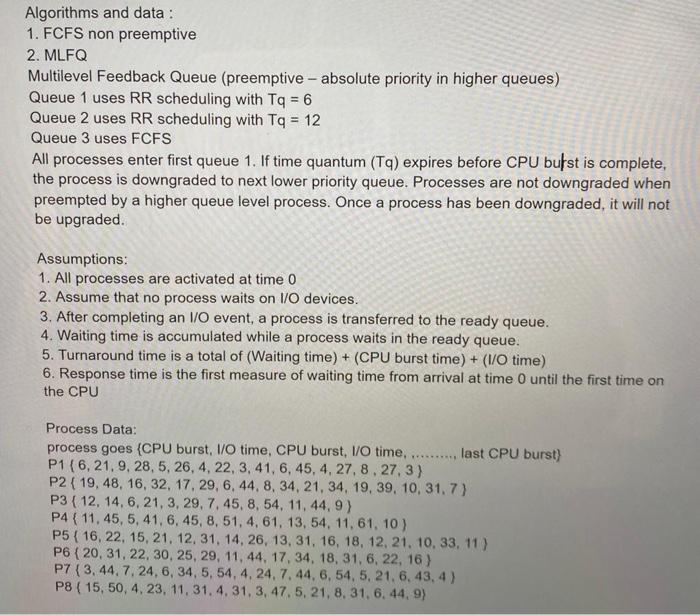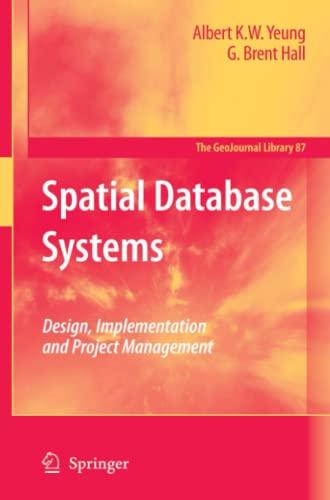5. Partial Gantt chart for MLFQ - at least 143 TIME UNITS 6. Calculate the PARTIAL results for Response Time (RT). Waiting Time (WT), Turnaround Time (TT) PER PROCESS and Averages as of time 143 for MLFQ Algorithms and data: 1. FCFS non preemptive 2. MLFQ Multilevel Feedback Queue (preemptive - absolute priority in higher queues) Queue 1 uses RR scheduling with Tq = 6 Queue 2 uses RR scheduling with Tq = 12 Queue 3 uses FCFS All processes enter first queue 1. If time quantum (Ta) expires before CPU bufst is complete, the process is downgraded to next lower priority queue. Processes are not downgraded when preempted by a higher queue level process. Once a process has been downgraded, it will not be upgraded. Assumptions: 1. All processes are activated at time 0 2. Assume that no process waits on 1/O devices. 3. After completing an I/O event, a process is transferred to the ready queue. 4. Waiting time is accumulated while a process waits in the ready queue. 5. Turnaround time is a total of (Waiting time) + (CPU burst time) + (1/O time) 6. Response time is the first measure of waiting time from arrival at time 0 until the first time on the CPU Process Data: process goes (CPU burst, I/O time, CPU burst, I/O time........... last CPU burst) P1 (6,21.9, 28,5, 26, 4, 22, 3, 41, 6, 45, 4, 27. 8. 27, 3) P2 ( 19, 48, 16, 32, 17. 29, 6, 44, 8, 34, 21, 34, 19, 39, 10, 31,7) P3 (12, 14, 6, 21, 3, 29, 7.45, 8, 54, 11, 44,9) P4 ( 11, 45, 5, 41, 6, 45, 8, 51, 4, 61, 13, 54, 11, 61, 10) P5 ( 16, 22, 15, 21, 12, 31, 14, 26, 13, 31, 16, 18, 12, 21. 10, 33, 11) P6 (20,31, 22,30, 25, 29, 11, 44, 17, 34, 18, 31, 6, 22, 16 ) P7 (3, 44,7, 24, 6, 34, 5, 54, 4, 24, 7. 44, 6,54,5, 21.6.43, 4) P8 ( 15, 50, 4.23, 11, 31.4, 31, 3, 47.5, 21, 8, 31, 6, 44,9) 5. Partial Gantt chart for MLFQ - at least 143 TIME UNITS 6. Calculate the PARTIAL results for Response Time (RT). Waiting Time (WT), Turnaround Time (TT) PER PROCESS and Averages as of time 143 for MLFQ Algorithms and data: 1. FCFS non preemptive 2. MLFQ Multilevel Feedback Queue (preemptive - absolute priority in higher queues) Queue 1 uses RR scheduling with Tq = 6 Queue 2 uses RR scheduling with Tq = 12 Queue 3 uses FCFS All processes enter first queue 1. If time quantum (Ta) expires before CPU bufst is complete, the process is downgraded to next lower priority queue. Processes are not downgraded when preempted by a higher queue level process. Once a process has been downgraded, it will not be upgraded. Assumptions: 1. All processes are activated at time 0 2. Assume that no process waits on 1/O devices. 3. After completing an I/O event, a process is transferred to the ready queue. 4. Waiting time is accumulated while a process waits in the ready queue. 5. Turnaround time is a total of (Waiting time) + (CPU burst time) + (1/O time) 6. Response time is the first measure of waiting time from arrival at time 0 until the first time on the CPU Process Data: process goes (CPU burst, I/O time, CPU burst, I/O time........... last CPU burst) P1 (6,21.9, 28,5, 26, 4, 22, 3, 41, 6, 45, 4, 27. 8. 27, 3) P2 ( 19, 48, 16, 32, 17. 29, 6, 44, 8, 34, 21, 34, 19, 39, 10, 31,7) P3 (12, 14, 6, 21, 3, 29, 7.45, 8, 54, 11, 44,9) P4 ( 11, 45, 5, 41, 6, 45, 8, 51, 4, 61, 13, 54, 11, 61, 10) P5 ( 16, 22, 15, 21, 12, 31, 14, 26, 13, 31, 16, 18, 12, 21. 10, 33, 11) P6 (20,31, 22,30, 25, 29, 11, 44, 17, 34, 18, 31, 6, 22, 16 ) P7 (3, 44,7, 24, 6, 34, 5, 54, 4, 24, 7. 44, 6,54,5, 21.6.43, 4) P8 ( 15, 50, 4.23, 11, 31.4, 31, 3, 47.5, 21, 8, 31, 6, 44,9)








